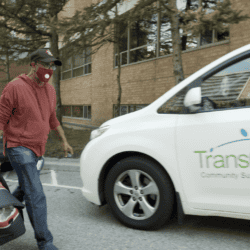This spring, we asked contributor Emily Mathieu to canvass some members of The Philanthropist Journal’s Editorial Advisory Committee – established in November 2020 to provide insights and input into our evolving coverage – and get their views on what the late- and post-pandemic period holds for the sector.
Publisher’s note: In November 2020, the Agora Foundation board of directors established an Editorial Advisory Committee whose members could provide input and insights into our evolving coverage of Canada’s philanthropic sector. We have drawn on their considerable experience in our reporting. This spring, we asked contributor Emily Mathieu to canvass some members of the EAC and get their views on what the late- and post-pandemic period holds.
—Leslie Wright
***
With the pandemic raging and the economy collapsing, the summer of 2020 held little promise for hundreds of thousands of young people who rely on seasonal work. But the Gord Downie & Chanie Wenjack Fund (DWF) was ready to employ Indigenous youth and was counting on a $50,000 grant to engage 200 young volunteers across Canada in research work on reconciliation.
“We said, ‘We’re set up to work remotely – we could take four or five students,” for jobs, says Sarah Midanik, DWF president and CEO and a member of the Métis Nation of Alberta. The fund prioritizes Indigenous youth, Midanik says, but will accept non-Indigenous candidates.
Then came the sort of one-two punch that would set even the most adept organization back on its heels. First, Ottawa said it would fund only two positions, through a program that caps pay at eight weeks. Then WE Charity, tapped to manage a massive youth volunteer program, imploded after Canadaland’s reporting kicked off a wave of public scrutiny, taking that modest grant with it.
The volunteer program was put on ice, temporarily, but a corporate sponsor stepped up and it will operate this summer, albeit with 50 volunteers. But not all agencies had the ability to pivot, meaning many young people went without jobs.
* * *
According to Imagine Canada, federal funding played a significant role in the sector’s short-term survival, with four out of 10 charities applying for emergency relief programs last year. While more than 80% of charities qualified for supports, “smaller charities and philanthropic intermediaries” were likely to be shut out, according to the organization. As many in the sector know firsthand, the experiences of groups like the Downie Wenjack Fund have been all too commonplace.
But after almost 15 months of COVID-19 and the prospect of a post-pandemic recovery at least visible, the charitable sector finds itself charting what it hopes will be a less dependent and more stable future.
While funding relationships with government remain crucial and were expanded somewhat in the April federal budget, sector leaders say they also want to forge new partnerships with private funders and fellow organizations to propel and sustain change.
Shortfalls in Canada’s pandemic response have provided an opening for charities and non-profits to adapt, strategize, and lead, according to a recent report prepared for the Calgary Foundation, entitled Unmasking the Future: 2021 Environmental Scan.
“We now have an opening of the window of possibilities for once-in-a-generation public policy innovation, amounting to essentially a new ‘social contract,’” writes the study’s author, James Stauch, director of the Institute for Community Prosperity at Mount Royal University.
While Canada’s federal response has been “generally competent, but far from world leading,” Stauch notes, it also shines a light on the “dysfunctional side of federalism” while “flummoxing” Canadians with “a bewildering patchwork of provincial and regional rules and regulations.”
In recent months, The Philanthropist reached out to members of the journal’s new Editorial Advisory Committee to talk sector handicaps and how charities and non-profits can rebuild in the post-pandemic future.
A dearth of meaningful data
Statistics Canada earlier this year released the results of a crowd-sourced survey on diversity at the board level. The results, The Philanthropist reported in February, confirmed what the sector already knew – that top-down decisions are being made by predominantly white boards of directors.
While the snapshot provided the kind of concrete information that should spur focused debate on representation, it also highlighted how little hard and current data about the sector exists overall. (See also EAC member Cathy Barr’s analysis of the data deficit, published in The Philanthropist May 4.)
“The number-one piece is that we don’t have good sector data,” says Marlene Deboisbriand, vice-president of member services and programs at BGC Canada (formerly Boys and Girls Clubs of Canada).
The lack of an in-depth understanding of the sector and its workforce not only limits strategic and operational discussions, she adds, but can also hamper lobbying efforts and meaningful transformation.
When it comes to labour-force data, the sector didn’t always operate in the dark, thanks to information collected and disseminated by Canada’s HR Council for the Nonprofit Sector. The group was disbanded in 2013 when federal funding was pulled.
In its June 2019 report, the Special Senate Committee on the Charitable Sector called for the council’s revival, stressing the need for a sector-wide HR plan, and called on the federal government to “support collaboration between Statistics Canada and the charitable and non-profit sector.”
Last year, Imagine Canada, the Ontario Nonprofit Network, and Community Foundations of Canada, which managed council resources and the original website until 2018, came up with a plan to relaunch the HR Council website this year.
In the April budget, the Liberals acknowledged the lack of “the detailed statistical data that governments, public institutions, academics, and advocates need in order to take fully informed policy actions and effectively address racial and social inequities.” Funding has been allocated for the collection of desegregated data, including on the non-profit and charitable sector.
But while they wait for those labour-force statistics, Deboisbrand says, charities and non-profits need to shift from survival mode and focus on restructuring. Achieving that goal will mean making tough decisions around funding and staff, including volunteers, current employees, and future hires, she says, and ultimately what organizations can and can’t offer their communities.
Equity is not optional
Charities and non-profits should be commended for their “heroic” work during COVID-19, but they must not turn their backs on the embedded and virulent national “crisis” of systemic racism, a leading voice for equity in Canada cautions.
“The scourge of racism holds back prospects for security, safety, and opportunity for all its victims,” Senator Ratna Omidvar wrote in an open letter to the sector that was published in The Philanthropist last summer. “But it has a particularly malignant effect on Black Canadians and Indigenous Peoples in Canada.”
The federal budget earmarked $300 million for Black-led charities and Black entrepreneurs, a response to reports that showed just how little philanthropic funding ends up in such organizations. Yet Raine Liliefeldt, director of member services and development at YWCA Canada, says that if Canadian charities and non-profits genuinely want to show true leadership, their boards need to commit to building organizations that reflect the diverse communities they serve.
“It doesn’t matter how many times we raise the bar” and pledge to make equity a priority at the board level, she says, organizations must be willing to do the work required to make real space for all voices at the table.
The next generation of diverse directors might be coming to the sector without the training, work connections, or wealth of existing board members, she says. Many may also face limitations on their time because of family, education, and employment obligations.
“Those disparities are striking,” Liliefeldt says, and can quickly become a deterrent to serving on boards. Agencies unwilling or unable to work around those practical concerns should be prepared to lose top talent, she warns.
Liliefeldt proposes the creation of a new standard to guide decisions around diversity, when it comes to both staff and board members; a standard created by the sector and potentially an outside party that all charities and non-profits can implement.
That standard should not only address a lack of diversity at the board level, she says, but build in ways that organizations can accommodate new hires and volunteers. Ideally, the funding for the development of such a standard would come through government, she adds.
Without an intentional and transparent approach to hiring and board recruitments, Liliefeldt says, agencies won’t attract and retain employees who are representative of the communities they serve. “If, at the end of the day, the person that we want to have at the table is not feeling comfortable enough to participate and have a meaningful experience, it’s just going to continue to fail.”
The revenue and fundraising hangover
One long-term sector challenge, spotlighted by COVID-19, is how piecemeal funding has failed to provide the long-term fiscal stability that non-profits and charities need to not just survive but drive change, Deboisbriand says. The pandemic has forced many organizations to reevaluate not only spending, but whether they can operate effectively on their own.
In most small and mid-sized organizations, Deboisbriand notes, “if you had a reserve fund at all, it’s gone.”
The federal budget included funding for skills training and capacity-building to access government programs as well as support for historically excluded groups, such as the National Aboriginal Capital Corporations Association and the Canadian Women’s Foundation.
Deboisbriand says many organizations still operate using a fee-for-service model. With demand for service at an all-time high, agencies should be able to shift gears and collaborate with outside organizations without risking that baseline funding.
“If you’re able to serve at all, if you’re open at all – because of social distancing and everything else, your numbers are much, much lower,” she says. “So your income line has decreased significantly.”
“Unfortunately, much of our sector is still doing special-events fundraising, and that has come to an absolute standstill,” she adds.
Prioritizing the environment
“We don’t have a lot of time on climate change,” says Vicki Stroich, engagement director with the Alberta Ecotrust Foundation. “We have to make some big things happen quickly. It’s also something, I think, that needs a sustained and scalable way of thinking.”
As part of that work, Alberta Ecotrust manages an endowment, seeded with $43.4 million in federal funds, and partners with industry, municipal leaders, local non-profits, and environmental advocacy groups for projects in Edmonton and Calgary. The goal, says Stroich, is to “accelerate” innovation and then provide organizations with the long-term supports needed to scale those projects.
James Stauch, at the Institute for Community Prosperity, says environmental organizations should collaborate with community agencies already invested in infrastructure, including housing providers, to push for as many green measures as possible.
Despite facing a climate crisis that “dwarves COVID in all respects,” he says, the environmental advocacy space remains “disproportionately reliant on a very small number of NGOs” that are largely reliant on private funding. “You would think the environmental, NGO presence on climate change in Canada would be more visible and more ubiquitous, but it’s really not.”
An additional option, he says, is a dedicated tax, pooled into a fund that is “ideally free from cabinet interference” and used strictly to fund climate action and climate innovation.
Diversity, or the lack of it, is another concern, Stauch adds. While First Nations, Métis, and Inuit Peoples are invested in ecological protection, he says, whether in ceded or unceded territories, individuals from these communities tend not to be represented within the environmental movement. The sector must commit to remedying that lack of representation and ensure equal partnerships with Indigenous groups, he says.
“If you’re saying you’re working really well with Indigenous groups, and you’re supporting their aims of self-determination, then surely you could be subcontracting these same First Nations and Inuit authorities,” he says. “Either you’re helpful or you’re a distraction.”
Aiming for Indigenous autonomy
The way Canada’s tax laws “perpetuate systemic racism,” particularly when it comes to Indigenous communities, was the subject of a recent op-ed in iPolitics, co-authored by Senator Omidvar and Kris Archie, who is Tsq’escen’te Secwepemc and CEO of The Circle on Philanthropy and Aboriginal Peoples in Canada.
Under current rules, charities seeking to fund not-for-profits, co-ops, social enterprises, and community groups, among others, must employ “direction and control” over any shared work funded by that money, the authors write.
For Indigenous organizations that are not registered charities, the only way to access such funds is “to consent to a very complicated and expensive agency agreement.” They must relinquish operational control as well as intellectual property rights and the right to have the final say on public statements.
Those “accountability mechanisms” limit progress and perpetuate the public misconception that Indigenous organizations must be aided with their own affairs, the authors point out.
“For those organizations and communities who are innovating solutions to child welfare, education, health – the added burden of increased scrutiny, paternalism, and undue direction doesn’t help make for efficient use of charitable dollars.”
Author and academic Niigaanwewidam James Sinclair says allyship from non-Indigenous agencies is needed, because of the federal government’s continued failure to honour its responsibilities to Indigenous Peoples. But, as part of a commitment to autonomy, such organizations should aim “to make themselves redundant,” he says.
“Philanthropy is inherently colonial, and it’s inherently about power,” adds Sinclair, who is Anishinaabe from St. Peter’s/Little Peguis and head of the Department of Native Studies at the University of Manitoba, where he is an assistant professor.
“Philanthropy only exists because of the failure of society to support people, to take care of people, to create a social network … It’s not because people are somehow inherently good.”
Pushing past politics
Even as vaccination campaigns roll out across the country and the promise of a return to some kind of normalcy takes shape, Canada’s charities and non-profits still face a long road ahead, says Ericka Alneus, philanthropic development advisor for Pour 3 Points in Montreal. But they should never underestimate the influence that organizing can have on civil society, she says.
Black Lives Matter, for example, changed the conversation around race and police violence across North America, and did so through the passion and relentless work of grassroots activists – entirely free from government, she observes.
Charities and non-profits are the “best assets in the political landscape,” Alneus adds, but they are often still seen as an emergency solution rather than an integral part of a healthy civic society.
“We are not puppets. We are experts. We know the field. When a crisis arrives [the government is] the first to knock on our doors.” Now is the time for non-profits and charities to step up their efforts to strategize on a national level, she says. Those conversations should start by looking to larger agencies with national expertise, such as the YWCA, as a means of guiding the wider changes that will be needed for the fight ahead.
What lies ahead
With summer approaching, the Gord Downie & Chanie Wenjack Fund is gearing up to launch the organization’s four-week project on reconciliation and to bring on two post-secondary students. DWF received funding for the two positions for eight weeks, at 35 hours a week at minimum wage, and Midanik says the fund will provide the money needed to boost the hourly rate and extend the positions to 16 weeks.
The deadline to apply for the volunteer positions, open to both Indigenous and non-Indigenous youth, is June 18. The 50 participants will be paid an honorarium to document examples of reconciliation nationwide.
While the April budget promised some $317 million “in new funding” for the Canada Summer Jobs program – the source of that partial funding for students – it was delivered with little detail and won’t result in placements or paycheques until 2022.
Samuelle Carbonneau, spokesperson for Employment and Social Development Canada, wrote in an email that additional funding was provided for this year’s program, which could support up to 150,000 volunteer and paid positions. Program rules limiting jobs to full-time positions during summer months have been temporarily lifted, in response to COVID-19, meaning employers can offer full- and part-time work from April to February, Carbonneau says. The funding remains capped at 35 hours a week for eight weeks.
Meanwhile, Midanik says the government needs to work with potential employers to create as many jobs, volunteer positions, and paid research opportunities as possible this summer.
“Think back to when you were a student, and you’re trying to make all the money for the entire year in those four months,” she says. “When all those opportunities dry up because those things aren’t operating right now, where else can they go and what opportunities can we provide?”


